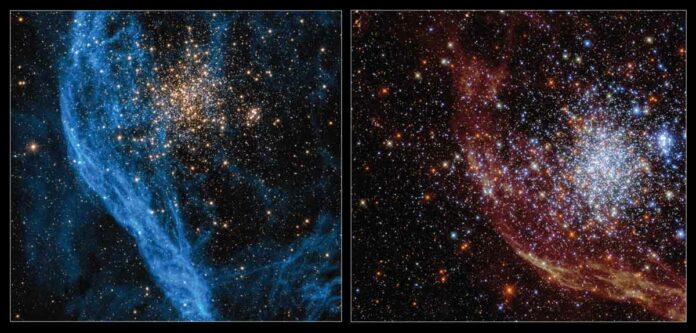These two images may appear to be diametrically opposed. But they are actually images of the same cosmic object NGC 1850. Both images were taken with the same Hubble telescope. Different filters with different assigned colors were used to study specific wavelengths of light emitted by these objects. The blue nebulosity image includes some near-infrared light as well as visible light. In comparison, the red nebulosity image covers a much broader range from near-ultraviolet to the beginnings of the infrared spectrum. This luminous, starry view and ultraviolet observations are ideal for detecting light from the hottest and youngest stars.
This 100-million-year-old globular cluster is found in the Large Magellanic Cloud. It is a Milky Way satellite galaxy that has given birth to billions of stars. The cluster is located in the constellation Dorado. It is approximately 160,000 light-years away. It is a spherical collection of densely packed stars held together by mutual gravitational attraction. Unlike most globular clusters, the stars in NGC 1850 are young. NGC 1850 is a globular cluster with young stars that does not exist in our own Milky Way galaxy.
When NGC 1850’s first generation of stars was born, the stars ejected matter such as dust and gas into the surrounding cosmos. The newly formed star cluster’s density was so high that the ejected matter could not escape the cluster’s gravitational pull. It forced it to remain nearby. The cluster’s intense gravity drew in hydrogen and helium gas from its surroundings. These two gas sources combined to form a second generation of stars, increasing the globular cluster’s density and size.
Scientists discovered the presence of a black hole in NGC 1850 in 2021. They have also discovered a large number of brighter blue stars. These stars burn hotter and die younger than red stars. Around 200 red giants are also present. These are stars that have run out of hydrogen in their cores and are fusing hydrogen further away from their core. It caused the outer layers to expand, cool, and glow red. A pattern of nebulosity, diffuse dust, and gas surrounding the cluster is thought to be the result of supernova blasts.
NGC 1850 has a mass of approximately 63,000 times that of the sun and a core diameter of approximately 20 light-years. Astronomers imaged this large star cluster using Hubble Space Telescope observations at a variety of wavelengths to learn more about star formation.

